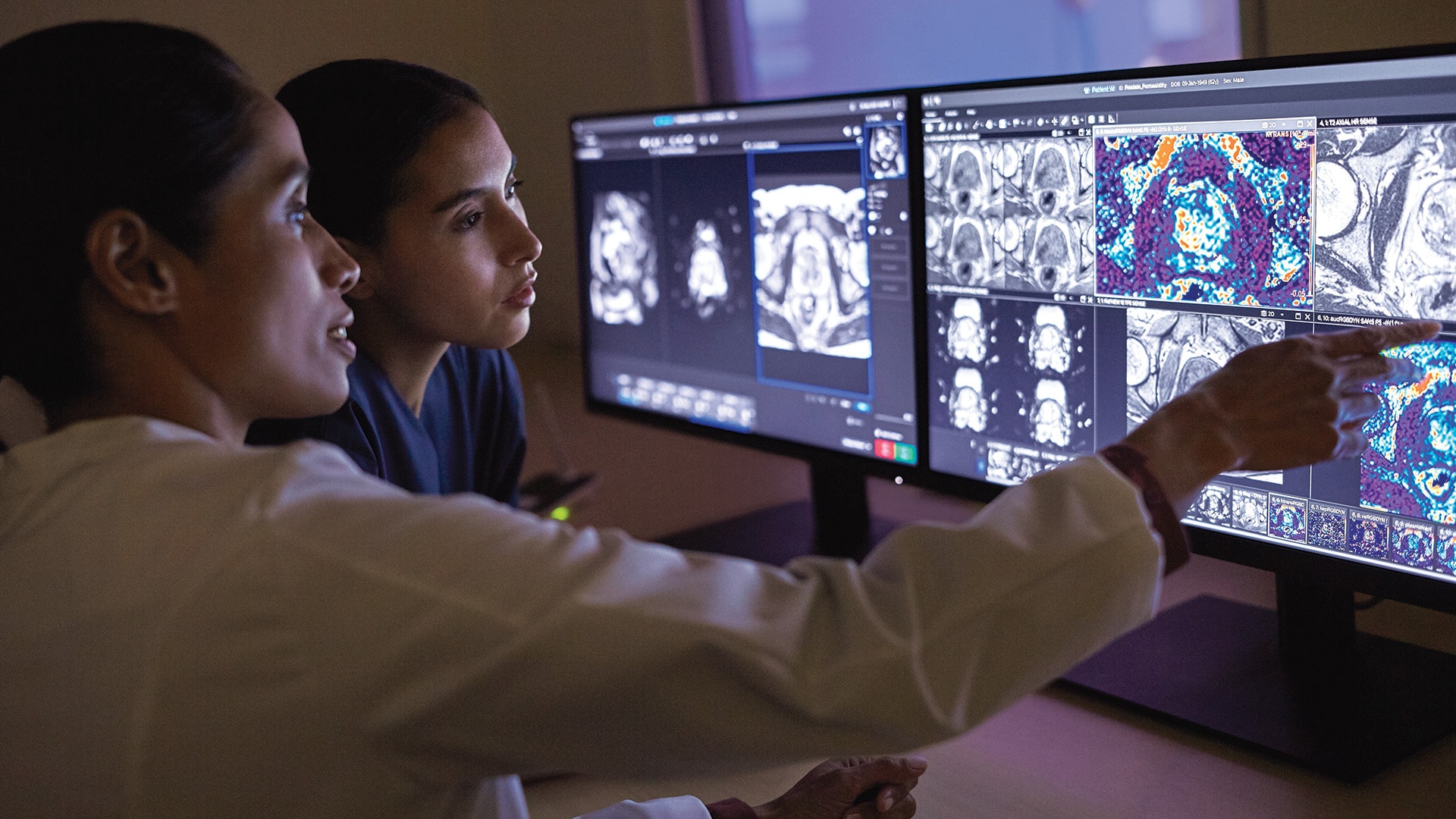The radiology burnout crisis is real. Here’s how we can give radiologists and staff back time.
Nov 20, 2023 | 7 minute read
Workforce shortages have put healthcare professionals under more pressure than ever before. Nowhere is this more apparent than in radiology, with radiologists ranking among the most burned-out specialists in a 2023 Medscape survey [1]. Radiology leaders have also raised alarm that labor shortages are leading to longer wait times and delays in treatment for patients [2]. Never has there been a bigger need to give radiologists and imaging staff back what they lack the most: time.

When I started working as a neuroradiologist in 1996, a CT examination of the brain consisted of 20 images. When, 15 years later, I transitioned from clinical practice to focus on driving digital innovation in healthcare, that number had risen to 1,200 – a 60-fold (!) increase. This remarkable explosion of data enabled me and my peers to diagnose conditions with more precision than ever before. But it was also an undeniable source of data overload. We didn’t have more time per study, nor had our workflows evolved at the same speed to support the efficient interpretation of so many images. What this points to is a fundamental asymmetry in radiology innovation. On the one hand, we have seen spectacular advancements in medical imaging technology – and it really is astonishing how innovations in MR, CT, ultrasound, and other modalities can now help radiologists obtain incredibly detailed and precise images of the human body. But on the other hand, radiology departments often lack the time and resources to manage the growing deluge of data and technological complexity – especially as they are running into the limitations of workforce shortages. To put it simply: radiology workflows have not kept up with the pace of imaging innovation. Addressing this asymmetry is what can help offer a way out of the radiology burnout crisis. It also aligns with what I’m hearing from customers. Ten years ago, they were primarily interested in the technical specifications of the latest imaging equipment. Today, their focus is on optimizing workflows to arrive at a faster, more accurate diagnosis. Radiology leaders are not looking for more pixels. Their focus is on how they can empower radiologists and staff with the right capabilities and insights to help them serve more patients more quickly. And for patients, time is of the essence too: it can mean the difference between cancer being caught at an early stage when it’s still treatable, versus it progressing undetected to an advanced and potentially life-threatening condition. That’s why we need to increase the pace of workflow innovation in radiology. It’s a prime focus of our sharpened strategic focus at Philips, with the launch of the industry’s largest enterprise informatics business earlier this year. Our goal in radiology? To help reduce the time to diagnosis, without compromising on quality. Let me give you five tangible examples of what that looks like and how it can benefit physicians, staff, and patients alike – starting at the point of image acquisition.
1. Virtual over-the-shoulder support with image acquisition
As imaging modalities such as MR and CT have advanced, so has the complexity in performing the exams. Radiology technologists have to pick the right protocols and parameters for each patient to ensure the best imaging results and enable accurate diagnoses. That can be a significant source of stress when the technologist lacks the required subspecialty expertise and there is no experienced colleague around to support. Unfortunately, this is exactly the reality that many of them are facing today, especially in smaller imaging sites. There are more unfilled vacancies for radiology technologists than any other group of allied health professionals [3], and they need extensive training to perform complex exams.
One way to address this problem is to offer a technologist a ‘guardian angel’ to look over their shoulder and provide virtual guidance and support. That has been the driving vision behind the Radiology Operations Command Center. On-site technologists can call on experts in a central hub for help with completing a scan or adjusting an imaging protocol, while the patient is still on the scanner table. Leading imaging providers are now embracing this model to empower staff across sites through remote collaboration and virtual scanning support. We are making easy and effortless what used to be challenging and time-consuming. For radiology departments, that means they can scale the expertise of their staff to remote areas, or conversely leverage remote experts, so they can serve more patients. And for patients, it means faster access to the right care.

2. Prioritizing images through smart workflow orchestration
When I used to read studies as a radiologist, one concern that was always on my mind was this: what if, from the innumerous studies I’m reading today, it’s the last study that turns out to be the one with an abnormality that requires urgent follow-up? Ideally, one doesn’t want that abnormal study to come last one on the reading pile. You want it to pop up first, so that you can alert the referring physician immediately. Smart workflow orchestration can enable precisely that. It automatically prioritizes and delegates cases to the right subspecialty radiologist at the right time and in the right order, based on various parameters including AI-based screening. This also helps to balance workloads across an imaging network – preventing one radiologist from getting overburdened when there is another radiologist working at 85% of their capacity. As a result, one healthcare organization was able to speed up its radiology workflows by 50% – significantly increasing its capability to provide timely, high-quality care to every patient [4].
3. Secure ‘anytime, anywhere’ access to medical images
Back in my days as a radiologist, everyone used to work in the same hospital building. How different that is today! After the pandemic normalized reading medical images from home, 65% of radiologists working for academic hospitals intend to continue reading remotely – a figure that is even higher in non-academic settings (82%) according to a recent study published in the Journal of the American College of Radiology [5]. In this new hybrid reality, workflows need to enable the fast and seamless exchange of radiology images and other medical information across locations, from the hospital to the home.
This need for ‘anytime, anywhere’ access to information is one of the major drivers behind radiology departments moving to the cloud. On-premises data centers are typically not equipped for the large outbound bandwidth that is needed to send vast amounts of medical images from the hospital to the home. Cloud-based imaging platforms are much better suited to these demands, allowing health systems to securely scale their remote imaging capabilities. Not only that, the scalable computing power of the cloud is also what enables radiology departments to tap into the transformative power of generative AI.

4. Enhancing clinical workflows with AI
AI in radiology used to be a curiosity – now it is a practice differentiator. To understand why, just think of the weather app on your phone. You are not looking for second-by-second meteorological data from thousands of sensors in nearby weather stations – you just want to know whether the sun will be shining an hour from now or whether you need to bring an umbrella when you walk out the door. It’s the same for radiologists, who often have a wealth of data but a poverty of insights. That’s where AI comes in.
By turning vast amounts of imaging data into meaningful insights, AI can reduce the cognitive burden on radiologists and enable them to focus their expertise where it matters most. For example, in CT lung cancer screening, where early detection is critical for better patient outcomes, AI can help radiologists identify lung nodules 26% faster and also detect 29% of previously missed nodules [6]. Or, as another example, AI can help triage patients who are admitted into the emergency department with suspected bone fractures, by automatically identifying radiography scans in which there is no immediate evidence of a fracture. As a result, radiologists get to concentrate on more complex and urgent cases, while patients benefit from reduced waiting times [7].
5. Integrated diagnostics for improved clinical collaboration
Imagine a pilot flying a plane and having to call the cabin crew to gather readings of altitude, airspeed, and navigation. It’s not far removed from the reality that radiologists face when they are trying to gain an overview of all relevant patient information, which is typically spread across disparate systems. My fellow radiologists and I used to say we had to “hunt and peck” for information, whether it was by opening another application or by calling the receptionist at the front desk to get more history or outside cases. We were trained to interpret studies – yet we spent much of our time clicking, scrolling, and making phone calls just to gather the data we needed. Worse yet: it tends to be the same for other physicians involved in diagnosing patients, including pathologists, cardiologists, and oncologists.
Integrated diagnostics can help create the cockpit that radiologists and other physicians often lack today, bringing together disparate data across domains to provide a comprehensive picture of the patient’s disease. Staying with cancer care as an example: by integrating radiology, pathology, and laboratory data in one view, we can enable all members of a care team to work together more efficiently and effectively. This also gives different specialists more insight into how consistent their findings are with each other, which creates a continuous feedback loop and may in some cases reveal a need for additional diagnostics. For cancer patients, that can mean the difference between an ideal or poor outcome because of earlier detection and diagnosis, as well as more precise and personalized treatment.
The hardware advancements in acquiring medical images have come a long way in recent decades. Now is the moment for innovations in informatics to catch up and improve the overall clinical workflow experience of the people interpreting those images. Because if there’s one thing that physicians and staff never have enough of, it’s time. And if we can give them back some of that time, it’s ultimately patients who benefit from faster and more accurate diagnosis and treatment.
To learn more about how Philips is partnering with healthcare leaders to help them optimize radiology workflows and reduce the time to diagnosis, join us in person or virtually at the upcoming RSNA annual conference. You can also follow @PhilipsLiveFrom for updates from #RSNA23.
Sources [1] https://www.itnonline.com/content/blogs/melinda-taschetta-millane-editorial-director/radiologist-burnout-crisis
[2] https://www.theguardian.com/society/2023/jun/08/cancer-patients-delays-treatment-staff-shortage-uk-radiologists
[3] https://radiologybusiness.com/topics/healthcare-management/healthcare-staffing/radiology-techs-especially-high-demand-85
[4] https://www.usa.philips.com/healthcare/case-study/enable-enhanced-productivity-by-orchestrating-radiologist-workflow
[5] https://www.sciencedirect.com/science/article/pii/S1546144023004106
[6] https://pubmed.ncbi.nlm.nih.gov/29336601/
[7] https://www.philips.com/a-w/about/news/archive/standard/news/articles/2023/20231120-philips-and-norwegian-vestre-viken-health-trust-deploy-ai-enabled-clinical-care-to-help-radiologists-improve-patient-care.html
Share this page with your network














